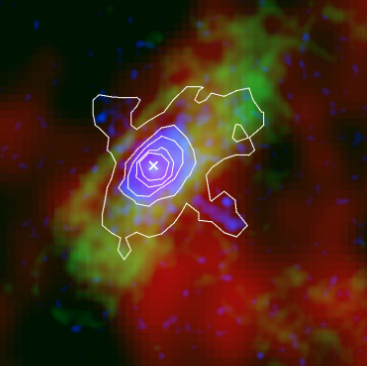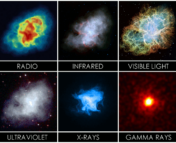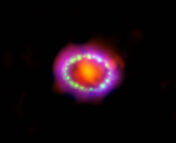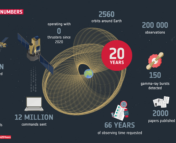Authors: Jooyun Woo, Hongjun An, Joseph D. Gelfand, Charles J. Hailey, Kaya Mori, Reshmi Mukherjee, Samar Safi-Harb, and Tea Temim
First Author’s Institution: Columbia Astrophysics Laboratory, 550 West 120th Street, New York, NY 10027, USA
Status: Published in APJ [open access]
Pulsar wind nebulae: little space animals

Pulsar wind nebulae (PWNe) are cosmic particle accelerators found all over the Milky Way (and other galaxies too!). They’re made by the winds of pulsars – rapidly rotating and highly magnetized neutron stars, which are remnants of massive stars – pushing out winds of particles into the environments around them. The most famous example of a pulsar wind nebula is the Crab nebula, which can be seen in Figure 1 as the small grey, tornado-esque structure located in the larger red supernova remnant leftover from the original star’s explosion around a thousand years ago.
The Crab nebula isn’t the only PWN with a fun nickname, in fact, most PWN and supernova remnants are named after animals that they (very) vaguely resemble. There’s the Mouse, the Goose, and the Kookaburra, just to name a few – and of course, the topic of today’s paper, the Dragonfly (see Figure 2). Besides slightly resembling animals, PWNe are also thought to be the factories producing the highest energy particles we detect on Earth. A new catalog of the highest energy gamma-rays ever seen (see this bite) either identifies or tentatively associates many of these energetic systems to be associated with pulsars or PWNe.

Looking for the Dragonfly with all sorts of different (wavelength) eyes!
The authors of today’s paper investigate the Dragonfly with multiple different telescopes that detect wavelengths of light across the electromagnetic spectrum to get a full picture of what’s going on with the particles accelerated in and around the nebula (see Figure 3). The multiwavelength emission is modelled to try to figure out if the Dragonfly is capable of accelerating particles (electrons, protons, and other things) up to PeV energies (Figure 3 shows what PeV means in terms of wavelength) that then interact to make gamma-rays, which would classify it as a PeVatron (a name that aptly describes any astronomical source that can accelerate particles up to PeV energies). We detect the highest energy charged cosmic rays up to PeV energies, but haven’t seen too many sources that emit gamma-rays at these energies due to instrumental limitations and other things like photon absorption. Since charged cosmic rays (usually protons) get deviated in their travels to Earth by the swirling magnetic fields of the Milky Way, we need to search for neutral particles of similar energies, like photons (i.e., gamma-rays) to find PeVatrons, since they trace a straight line back from the particle to its source.

Using model fitting, the authors can create and evolve a pulsar and PWN to match the observed data, which gives them information like the nebular age, the expected shape of the nebula’s emission, and whether or not it can be a PeVatron, among many other interesting clues that help narrow down what’s going on with the particles and material in this system.
In particular, one interesting thing the authors notice is that the shape of the Dragonfly is highly long and asymmetric in soft X-ray wavelengths (and potentially in other wavelengths, but it’s hard to say due to much coarser angular resolution; see Figure 4b). Usually we’d expect to see a more spherical shape, so the explanation for this could be that the pulsar that’s powering the PWN is zooming through space at an unusually high speed or (more likely) that the PWN lives within a supernova remnant that hasn’t been seen yet. The interaction of particles from the PWN with the supernova remnant can cause some funky shapes to appear in the surrounding material. The authors suggest looking at the Dragonfly with a long exposure in radio wavelengths might be able to pick up signs of a supernova remnant that are overwhelmed in other wavelengths by the bright PWN to confirm this scenario.

By looking at the full multi-wavelength picture (see Figure 4), the authors note that the size of the PWN decreases with increasing energy in X-rays wavelengths (this isn’t apparent in Figure 4d, because HAWC isn’t able to resolve small structure and blurs everything out to look bigger than it is), meaning that the the PWN becomes a less efficient particle accelerator as we move to higher energies. By modelling this behaviour, the authors find a maximum particle energy of 1.4 PeV, meaning that the Dragonfly really can be a PeVatron.
Maybe a PeVatron? We’ll have to wait and see!
There’s still more work to do to figure out if we can actually see gamma-rays at energies beyond a PeV from the Dragonfly and to figure out how particles are being transported around the nebula to get the weird asymmetric shape that today’s authors observed. More observations using existing radio, X-ray, and other instruments as well as future ultra high energy gamma-ray telescopes (like SWGO and CTAO-South) can help answer these questions and help us get an even more full picture of the Dragonfly.
Astrobite edited by Lucie Rowland
Featured image credit: Jin et al., 2022




